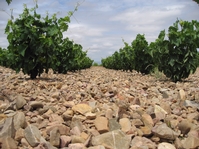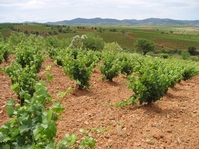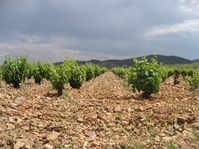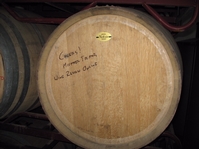|
|
 |

I’ll bet that you’ve heard this story before, but I’ll also bet that you’ll share my opinion that it’s the sort of story that never grows tiresome: “Traditional Spanish wine region with ideal climate and very old vines finds new sense of purpose and sends delicious, high value wines into world markets.”
Attentive wine lovers have been hearing variations on this theme for fifteen years now regarding various regions in Spain. No wine producing country has ever mustered such a sudden, broadly based vinous renaissance with such a steep trajectory. The only one that has ever come close was Italy between 1985 and 2000.
Since 1997, I’ve traveled to taste this renaissance-in-progress at least once every year, and often two or three times. Today, you can fly into Madrid and from there--smack in the middle of the Iberian Peninsula--set off toward any point on the compass to find exactly the same thing: Excellence where you’d have found mere potential a decade ago, and where you’d have found widespread mediocrity a decade before that.
If you want yet another case in point, we can head northwest on the road toward Aragon and the lovely city of Zaragoza, where we’ll find ourselves in the region of Cariñena in less than two hours. The rolling countryside is quite attractive but strewn almost everywhere with rocks, making it look a little forbidding for almost anything less hardy than a gnarly old vine with a really long taproot. find ourselves in the region of Cariñena in less than two hours. The rolling countryside is quite attractive but strewn almost everywhere with rocks, making it look a little forbidding for almost anything less hardy than a gnarly old vine with a really long taproot.
There are plenty of those, consisting mostly of Garnacha and Tempranillo (35% and 32% of the area, respectively, planted to red grapes), along with French varieties like Cabernet Sauvignon, Syrah and Merlot, and some local curiosities such as Vidadillo. There’s also some Cariñena (a quality vine variety known as Carignane in France, Carignano in Italy and Mazuelo in Rioja), but a lot less than you’d guess based on the name of the growing region. The percentage stands at less than 6% of red varieties, which is a little surprising since the possibility of achieving a commercial advantage from double-barreled name recognition has long been an appealing  prospect. Yet the Cariñena vine is particularly susceptible to the malady of oidium, and though some additional plantings are underway, Garnacha is spreading more rapidly. prospect. Yet the Cariñena vine is particularly susceptible to the malady of oidium, and though some additional plantings are underway, Garnacha is spreading more rapidly.
Although Cariñena also has plenty of white vine varieties planted, nearly 93% of them are Viura (a.k.a. Macabeo). This isn’t a highly regarded cultivar, and a lot of the grapes end up being distilled. Cariñena produces almost 10 times as much tonnage in red varieties as white, so--aside from some quite good bottlings of Chardonnay and Garnacha Blanca and some appealing sweet wines made from Muscat--you wouldn’t be wrong to think of Cariñena as red wine country along with regions such as Toro or Priorat.
Despite the fact that the rocky surface of many portions of the appellation are the most memorable, Cariñena has enough variation  in soils to provide some interesting internal contrasts. Some areas are rich in limestone, whereas others are alluvial or based predominantly on slate. in soils to provide some interesting internal contrasts. Some areas are rich in limestone, whereas others are alluvial or based predominantly on slate.
When you add these soil variations to the variables stemming from different altitudes and microclimates and throw in a range of different grape varieties sourced from old, head-pruned vines, you get a broad spectrum of interesting wines. The following reviews will hopefully provide an initial sense of the range offered by the Cariñena D.O., but of course there’s no substitute for tasting these wines yourself. I’ve provided rough indications of retail pricing where possible:
WHITES:
Bodegas Pablo Menguante Garnacha Blanca 2010: This shows an unusual degree of character for Garnacha Blanca, perhaps owing to the 12 hours of skin contact to which the juice was exposed prior to pressing and fermentation. Lovely peach aromas and flavors are quite expressive and appealing, with very impressive overall balance between substance  and freshness. 91 and freshness. 91
Aylés Chardonnay “Dorondón” 2010: Remarkably fresh and mineral, this enduringly interesting Chardonnay features complex fruit notes recalling peaches, apples and citrus fruits. With medium body but full flavor, it finishes with persistence and precision thanks to exceptional acidity, most likely due to malolactic fermentation having been blocked to preserve crisp malic acid. Purportedly imported by Guy Anderson Wine and priced at about $13. 91
Bodegas Añadas Chardonnay “Care” 2010: All of the wines from this very modern bodega are sold under a brand called “Care,” which is a play on the Spanish word for “face” as well as the Roman word for Cariñena. This wine shows excellent freshness despite having plenty of weight and flavor impact, with generous notes of ripe peaches and fine balancing acidity. Priced at about $14 and imported by Axial Wines. 90
REDS:
Bodegas Pablo, Finca Santiaga “Grand Viu” 2002: A blend of 60% Garnacha, 20% Cariñena and 20% Vidadillo, this terrific wine shows an amazingly complex bouquet featuring notes of leather, pipe tobacco and spices, but backs up those developed scents with a mélange of fresh primary fruit notes (bright cherry) and riper, softer suggestions of stewed fruits. Weighing in at 15.5% alcohol but not showing the slightest hint of heat, this is a phenomenal, almost uncanny wine due to its combination of remarkable freshness with developed aromas and rich fruit. Purportedly priced around $100 and imported by Frontier Wine Imports in New Jersey. 96
Sierra de Viento Garnacha “Centenaria Gran Selección” 2006: Big and bold in all respects but still impressively balanced in all respects, this is clearly an outstanding wine. Rich in texture and deeply savory in flavor, with dark cherry fruit that is pure and persistent despite a serious dose of oak that lends lots of interesting accents around the edges. Only 1,500 bottles of this were made, but every one of them is worthy of a search. 93
Bodegas Añadas “Care XCLNT Limited Edition” 2006: A high-end blend of 40% Garnacha, 40% Cabernet Sauvignon and 20% Syrah, this shows lots of muscle but doesn’t seem remotely over-ripe or over-extracted. Similarly, there’s lots of appealing notes of spice and woodsmoke thanks to 16 months of ageing in new Allier oak, and yet dense, dark fruit is easily up to the challenge of counterbalancing it. Serious stuff that will improve for at least another five years, this is priced at about $5 to $60 and is imported by Axial Wines. 91
Bodegas Ignacio Marin Gran Reserva “Barón de la Joyosa” 2001:  In my opinion 2001 was the finest vintage for red wines in north-central Spain in the past 20 years, and this wine displays the balanced complexity that it the hallmark of that growing season. The color remains deep and vital after a decade, with primary fruit still showing on the palate and a hint of sweetness buffering the tannins in the finish. Lovely aromas of leather and spices initially suggest a fully mature wine, making the fresh sweetness of the fruit an especially pleasant surprise. 91 In my opinion 2001 was the finest vintage for red wines in north-central Spain in the past 20 years, and this wine displays the balanced complexity that it the hallmark of that growing season. The color remains deep and vital after a decade, with primary fruit still showing on the palate and a hint of sweetness buffering the tannins in the finish. Lovely aromas of leather and spices initially suggest a fully mature wine, making the fresh sweetness of the fruit an especially pleasant surprise. 91
Grandes Vinosy Viñedos “Monasterio de las Viñas” Reserva 2006: A blend of garnacha, Tempranillo and Cariñena, this complex wine wraps accents of vanilla, spices and woodsmoke around a core of black cherry fruit. Still fresh and sweet in its fruitiness, but also savory and enduringly interesting. 90
Bodegas Prinur Viñas Viejas 2006: A blend comprised of Tempranillo, Cabernet Sauvignon, Garnacha, Cariñena and Vidadillo, this is based on red cherry and dark berry fruit, with a backnote of cranberry and appealing accents of smoke and spices from oak. Although it is already quite appealing, there’s still room for development in this wine. 90
Bodegas Convinca “Terrai G 06” Garnacha 2006: Soft and inviting in texture, this shows fine depth of flavor with dense fruit recalling both red and black cherries. There’s plenty of smoke and spice from oak showing in the wine’s aromas, but wood notes don’t overwhelm the fruit or dry the finish. Very high quality fruit, very deftly rendered. 90
Bodegas Solar de Urbezo Reserva 2006: A modern-styled blend of Cabernet Sauvignon, Merlot and Syrah, this was sourced from wire-trained fruit and shows a ripe, sweet, meaty profile. Some emerging aromatic complexities get it off to a good start, and the appealing flavors are firmed up by just the right dose of grippy tannins. 90 from wire-trained fruit and shows a ripe, sweet, meaty profile. Some emerging aromatic complexities get it off to a good start, and the appealing flavors are firmed up by just the right dose of grippy tannins. 90
Bodegas San Valero “Sierra de Vento” Old Vine Garnacha 2008: This shows some accents from American oak, but the wine was only exposed to the barrels after they had already been used in two previous vintages, so the wood notes don’t overwhelm the very appealing fruit. Gutsy and full-bodied but still delicate in texture, this shows nice spicy, savory qualities around the edges, and is a very attractive buy at $12. 89
|
 |
|